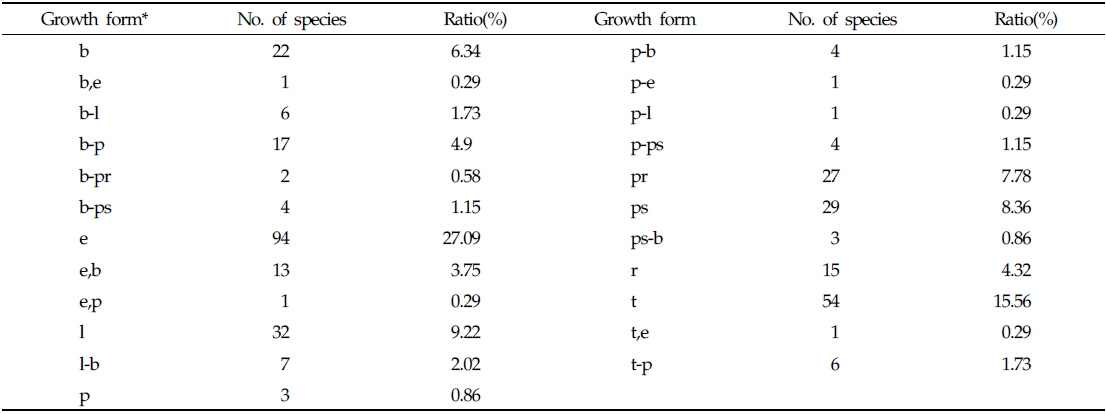



The field margins, which are uncultivated area of permanent vegetation located adjacent to field, play an important role in enhancing biodiversity in the agricultural ecosystem. This study focused on floristic characteristics on dry field margins in Korea Peninsula.
This study was conducted at margins of 196 dry fields in 32 areas in 8 provinces in May and September 2013. The vascular plants of the dry field margins were listed 347 taxa which contain 73 families, 219 genera, 311 species, 1 subspecies, 30 varieties and 5 forms. Of these 347 taxa, 48 taxa were woody plants and 299 taxa were herbaceous plants. Among total 73 families, Compositae (17.6%) was the most dominant family, and followed Gramineae (15.9%), Polygonaceae (5.8%), Leguminosae (4.9%) and Cyperaceae (3.8%). Based on relative frequency values of survey fields, the appearance frequency of
These results will be used fundamental data for studies to improve or even stabilize the current state of plant biodiversity in agricultural environments.
인간의 지속적인 관리가 이루어지고 있는 경작지에는 상대적으로 생활력이 강하고 번식력이 뛰어난 식물이 주로 생육한다. 일반적으로 잡초라 불리는 이러한 식물들은 포복형, 분지형의 생육형을 통한 빠른 번식과 탈립성이 강한 다량의 종자 생산 및 분산을 통해 경작지 주변부에 우점한다(Song, 1997). 잡초와 작물은 경쟁관계에 있으며 잡초의 발생과 작물의 수량과는 밀접한 관계를 가지고 있어 국내에서는 잡초의 효과적인 방제 및 관리를 위한 조사연구가 주로 수행되어져왔다(Kim, 1970; Park
국외에서는 경작지 주변부에 서식하는 식물이 작물의 생육에 영향을 미치는 생태적 기능에 대한 관심이 늘어나고 있으며(Van Emden, 1990; Wiens, 1992; Bennet
그러나 최근 수십 년 동안 경작지 주변부의 식물다양성은 크게 감소하고 있으며(David and Marein, 2000), 이로 인해 농업시스템에서 제공되는 생태계 서비스 기능(미세기후조절, 수문과정, 해충제어, 유해물질 제거 등)이 축소되고 있다(Altieri, 1999). 국내에서는 잡초 방제를 위한 재배작물별 현황조사(Kim,
본 연구는 국내 밭 경작지 주변부에 서식하는 식물의 다양성을 확인하고 생태적 특성을 밝혀 향후 국내 경작지 생태계의 기능적 연구와 인위적인 관리로 인해 나타나는 식물상 변화 예측 및 농경지 생물다양성 증진을 위한 기초자료를 제공하고자 수행하였다.
조사지역은 경기도(남양주시, 이천시, 파주시, 화성시), 강원도(춘천시, 홍천군, 원주시, 평창군), 충청북도(괴산군, 옥천군, 청원군, 충주시), 충청남도(공주시, 논산시, 당진시, 홍성군), 전라북도(고창군, 김제시, 임실군, 정읍시), 전라남도(영광군, 영암군, 진도군, 해남군), 경상북도(문경시, 김천시, 칠곡군, 안동시), 경상남도(창녕군, 함안군, 김해시, 밀양시)에 분포하고 있는 밭경작지의 주변부를 대상으로 하였다(Fig. 1). 각 도별 4지역을 대상으로 총 32개 시·군에서 196 밭필지의 주변부에 서식하는 식물종이 조사되었다. 각 지역의 조사지는 밭경작지의 특성을 나타낼 수 있도록 최소한 5필지가 연속적으로 연결된 곳을 임의로 선정하였다.
식물상 조사는 2013년 5월 및 9월에 2차례 수행하였으며, 밭필지와 접하고 있는 밭둑과 밭둑경사면을 조사범위로 설정하여 조사하였다(Cho
조사된 식물의 생태적 특성을 확인하고자 생활형(life form)을 분석하였다. 생활형은 Raunkiaer(1934)와 Numata(1969)의 방법으로 국내 식물종에 적용하여 Lee(1996b)가 제시한 휴면형, 번식형(지하기관형, 산포기관형), 생육형으로 구분하여 정리하였다. 그리고 휴면형을 이용한 교란지수(Di; Disturbance index, Benabdelmoumence
국내 밭경작지 주변부에 서식하는 식물종은 73과 219속 311종 1아종 30변종 5품종으로 총 347분류군이었다(Table 1). 이 중 목본식물(woody plant)이 48분류군(13.83%), 초본식물(herbaceous plant)이 299분류군(86.17%)으로 나타났고 목본식물의 25.00% (12분류군)는 산지임연부에서 주로 관찰되는 호광성의 덩굴식물(댕댕이덩굴, 청미래덩굴, 개머루, 으름덩굴, 인동덩굴 등)이었다(Appendix 1). 본 조사에서 조사된 299분류군의 초본식물은 최근 조사된 밭잡초 112분류군(Lee
[Table 1.] The main families of vascular plants on dry field margins in Korean Peninsula
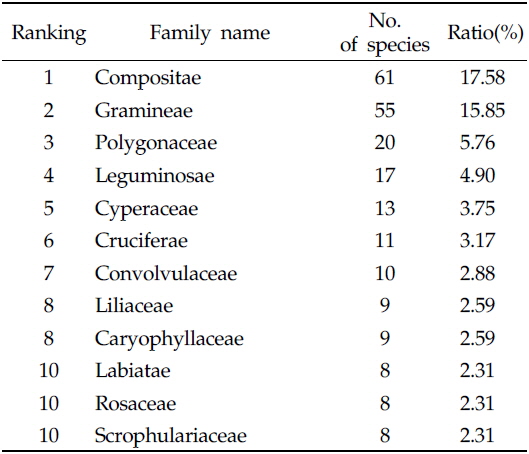
The main families of vascular plants on dry field margins in Korean Peninsula
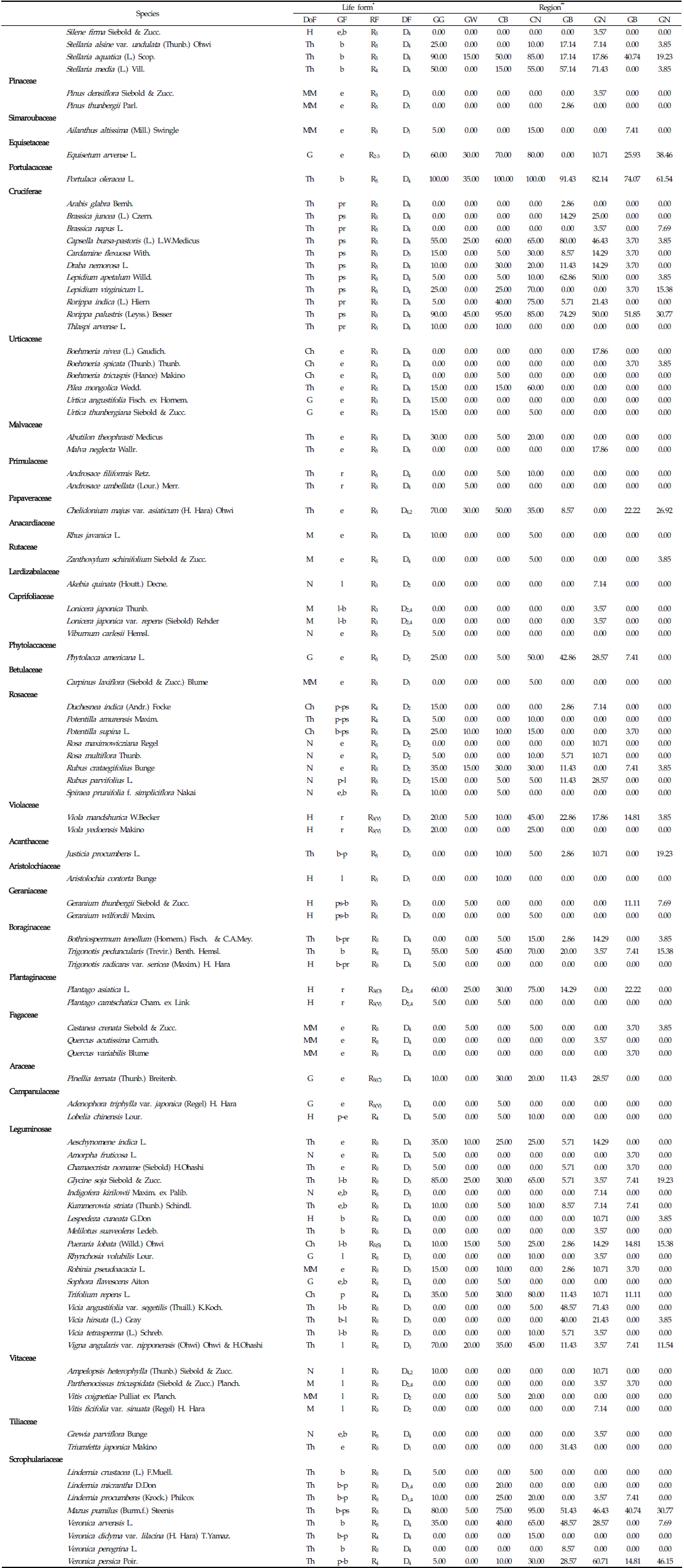
The list of vascular plants on dry field margins in Korean Peninsula (value : relative frequency)
과별 발생현황을 살펴보면, 국화과(Compositae)가 61분류군으로 전체 식물종 가운데 17.58%를 차지하였다. 다음으로는 벼과(Gramineae) 55분류군(15.85%), 마디풀과(Polygonaceae) 20분류군(5.76%), 콩과(Leguminosae) 17분류군(4.90%), 사초과(Cyperaceae) 13분류군(3.75%) 등으로 확인되었다. 상위 10개 과에 포함되는 식물종은 229분류군으로 전체 출현식 물종의 65.99%를 차지하는 것으로 분석되었고 출현식물종이 일부 과에 편중되는 양상을 보였다. 이는 Lee
식물분류체계별로는 양치식물(Pteridophyta) 2과 3분류군(0.86%), 나자식물(Gymnospermae) 1과 2분류군(0.58%), 피자식물(Angiospermae) 70과 342분류군(98.56%)이었으며, 이 중 쌍자엽식물(Dicotyledoneae) 257분류군(74.06%), 단자엽식물(Monocotyledoneae) 85분류군(24.50%)이었다. 밭경작지 주변부에는 양치식물과 나자식물의 서식빈도가 매우 낮은 것으로 분석되었다(Table 2).

The number of vascular plants by the taxonomic category on dry field margins in Korean Peninsula
지역별 출현현황을 살펴보면, 경기도에서 가장 많은 51과 191분류군의 식물종이 관찰되었으며, 다음으로 충청남도 56과 190분류군, 전라남도 51과 175분류군 등의 순이었다. 지역별 출현식물종의 상대빈도를 활용하여 집괴분석(cluster analysis)에 의한 지역별 유사성을 분석한 결과, 3개의 그룹으로 구분(경기도와 충청도, 전라도, 강원도와 경상도)되었다(Fig. 2). 경기도와 충청도에는 흰명아주, 청비름 모시물통이, 봄망초, 푸른방동사니가 특징적으로 출현하고 있었으며, 전라도에는 살갈퀴, 큰메꽃, 실망초, 민바랭이가 타 지역보다 높은 출현빈도를 보였다. 강원도와 경상도를 구분짓는 특이 식물종은 관찰되지 않았지만 타지역에 비해 출현종수가 낮은 것이 특징적이었다(Appendix 1). 이는 재배작물에 따른 제초관리와 조사 경작지의 위치적인 차이 때문일 것으로 생각된다.
식물종의 출현빈도를 살펴보면, 총 196필지에서 벼과인 바랭이의 출현빈도 89.80%(176필지)가 가장 높았다. 다음으로 깨풀(86.22%), 쑥(82.14%), 닭의장풀(80.61%), 쇠비름(80.61%), 개망초(78.57%), 망초(78.57%) 등의 순이었다(Table 3). Kim
[Table 3.] Relative frequency of the vascular main plants on dry field margins in Korean Peninsula
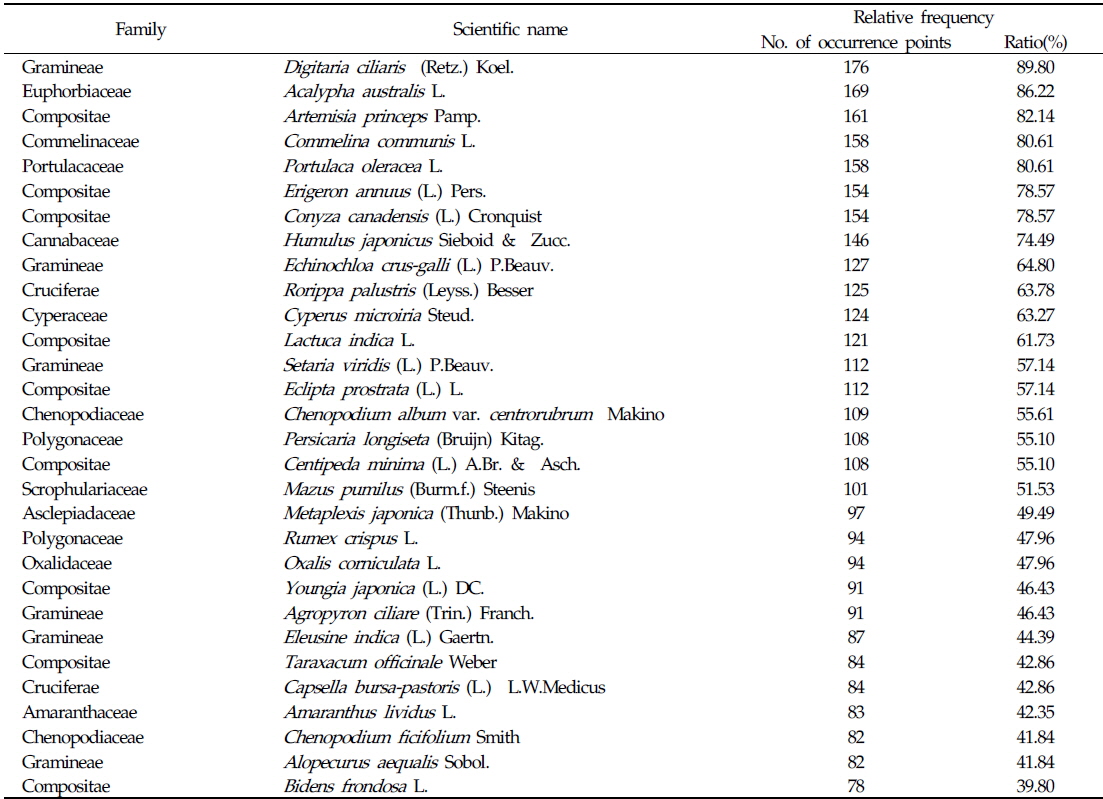
Relative frequency of the vascular main plants on dry field margins in Korean Peninsula
조사지역에서 확인된 347분류군의 Raunkiaer의 휴면형 분석결과, 일년생식물(Th)이 176분류군(50.72%)으로 가장 많이 조사되었으며 다음으로 반지중식물(H, 20.17%), 지중식물(G, 8.93%) 순으로 나타났다(Table 4). 경작지 주변은 답압, 예취, 제초 등의 인위적인 교란이 빈번하기 때문에 다년 생식물 보다는 교란지역에 대한 적응력이 상대적으로 뛰어난 일년생식물이 생육하기에 더 적합한 것으로 여겨진다. 일년생식물과 반지중식물의 높은 출현은 밭경작지 잡초연구에서도 유사하게 나타났다(Ishimine, 1987; Takaesu, 1991). 그리고 밭경작지 주변부는 해발고도가 낮은 산지와 인접하고 있는 곳이 많기 때문에 목본성식물도 일부 공유하는 것으로 나타났다. 지역별 휴면형 양상도 전국적인 출현양상과 큰 차이는 없는 것으로 분석되었다.
[Table 4.] Dormancy form of Raunkiaer and Disturbance index of the 8 regions
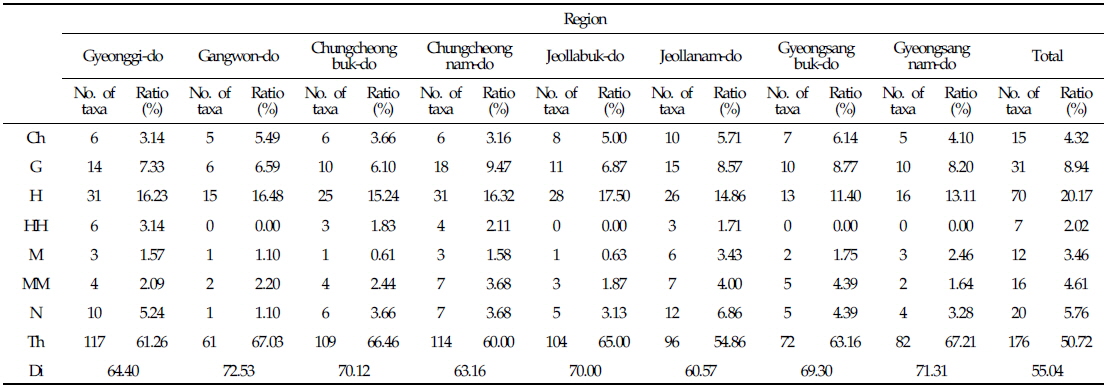
Dormancy form of Raunkiaer and Disturbance index of the 8 regions
휴면형을 활용하여 분석된 전국 밭경작지 주변부의 교란지수는 55.04%로 분석되었고 지역별로 강원이 72.53%으로 가장 높았고 다음으로 경남, 충북, 전북 등의 순으로 서식입지가 불안정하였으며 전남이 60.57%로 가장 낮았다(Table 4). 향후 밭둑의 제초관리 및 교란에 대한 추가적인 조사를 병행하여 연관성을 밝혀야 할 것으로 생각되었다.
전체 347분류군의 식물종의 번식형 중 지하기관형은 지하나 지상에 연결체를 만들지 않고 단립하는 R5의 식물이 67.72%(235분류군)로 가장 많이 출현하였고 근경이 옆으로 넓게 또는 좁게 벋는 R1, R2, R3, R4 그리고 이들의 조합형도 총 32.28%(112분류군)으로 많이 출현하였다(Table 5). 밭둑이 인위적인 답압, 제초관리의 영향을 주기적으로 받는 입지이기 때문에 영양번식이 양호한 식물종들이 타 식물과의 경쟁에서 우세했을 것으로 생각된다. 산포방법은 특별한 산포기관이 없이 중력에 의해 모체 주변에 종자가 떨어져 번식하는 중력산포형(D4)이 51.87%(180분류군)로 가장 많았고 다음으로 종자가 가볍고 관모와 같은 부속체를 가지고 있어 바람에 의해 쉽게 종자가 산포되는 풍수산포형(D1)이 18.16%(63분류군)를 차지하는 것으로 확인되었다(Table 5). 풍수산포형 식물은 개망초, 망초, 뽀리뱅이, 서양민들레 등과 같은 국화과식물이 여기에 포함되는데 총 61분류군 가운데 41분류군이 속하였다. 또한 2종류의 산포형을 모두 가지는 조합형의 산포형도 14.41%(50분류군)로 다수 관찰되었는데 산림(8.05%, Kang
[Table 5.] Propagation form of 347 vascular plants on dry field margins in Korean Peninsula
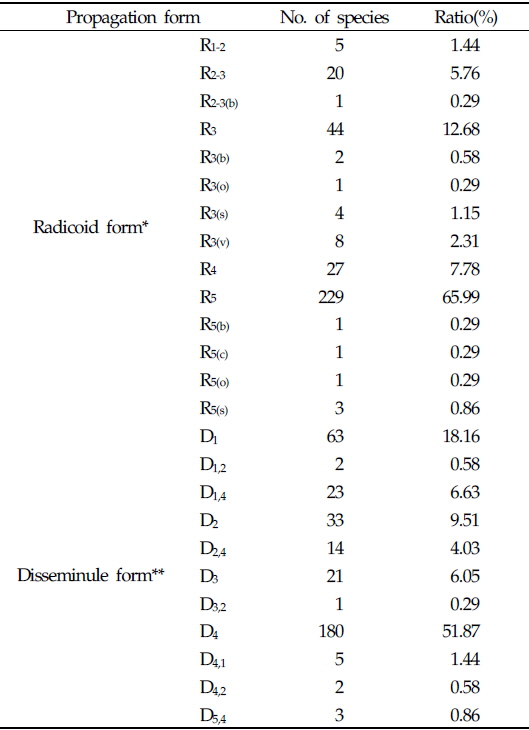
Propagation form of 347 vascular plants on dry field margins in Korean Peninsula
생육형은 직립형(e)과 총생형(t)이 각각 94분류군(27.09%)과 54분류군(15.56%)으로 높게 나타났으며(Table 6), 식물이 다른 물체를 감거나 기어 올라가는 넌출형(l)과 넌출형을 포함하는 조합형(b-l, l-b, p-l)의 출현빈도도 13.26%(46분류군)로 높게 나타났다. 이는 전술한 바와 같이 밭경작지 주변부는 구릉성 산지와 인접해 있어 임연부에서 주로 관찰되는 덩굴성식물들이 다수 혼생하고 있었기 때문이다. 또한 산림(Kang
[Table 6.] Growth form of 347 vascular plants on dry field margins in Korean Peninsula

Growth form of 347 vascular plants on dry field margins in Korean Peninsula
경작지 내부와 구별되는 경작지 주변부는 작물 이외의 식물과 동물에게 생육, 월동 및 은신 등을 위한 중요한 장소이다. 특히, 밭경작지 내에 출현하는 대부분의 식물종은 이러한 밭경작지 주변부에서 주로 생육한다. 따라서 본 연구에서는 농경지 생물다양성 보전에 중요한 역할을 하는 밭경작지 주변부에 생육하는 식물종의 종조성 및 그 특성을 밝히고자 하였다. 식물조사는 전국을 대상으로 2013년 5월과 9월에 8개 지역의 밭경작지 196 필지에 속하는 주변부를 대상으로 수행되었다. 그 결과, 총 73과 219속 311종 1아종 30변종 5품종을 포함하는 347분류군의 식물종이 확인되었고 이 중 48분류군이 목본이었으며 299분류군이 초본식물이었다. 과별로 국화과(17.6%)가 가장 높은 빈도로 출현하였고 다음으로 벼과(15.9%), 마디풀과(5.8%), 콩과(4.9%), 사초과(3.8%) 순이었다. 조사지점에 대한 상대빈도는 바랭이가 89.8%로 가장 높았고 다음으로 깨풀(86.2%), 쑥(82.1%), 닭의장풀(80.6%), 쇠비름(80.6%), 개망초(78.6%), 망초(78.6%) 등의 순이었다. 조사된 8개 지역은 종조성에 의해서 3개의 그룹으로 구분되었다. 전체 347분류군을 대상으로 한 교란지수는 55.0%로 산출되었고 지역별로는 강원지역이 72.5%로 가장 높았다. 생활형 조성은 Th-R5-D4-e로 나타났다. 이러한 생활형 특성은 건조한 토양수분조건, 빈번한 교란, 산림과 인접한 위치적 요소 등의 환경조건을 반영한 것으로 향후 경작지 주변부의 생태적 기능 및 종조성 변화에 대한 연구에 도움이 될 것으로 기대된다.









